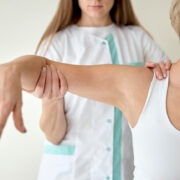Ocena błędu odczuwania pozycji kątowej dwa lata po przebytym skręceniu Ii I/II stopnia stawu skokowo-goleniowego leczonego zachowawczo – Aleksandra Wysocka

Prezentujemy streszczenia (w jęz. polskim oraz j. angielskim) prac naukowych nadesłanych w ramach konkursu na najlepsze wystąpienie dotyczące interdyscyplinarności w fizjoterapii podczas II kongresu KIF.

W kategorii „WYSTĄPIENIA USTNE. Sesja dla studentów, studenckich kół naukowych” – 1 miejsce zajęła Aleksandra Wysocka
(Na zdjęciu: dyplom odbiera reprezentant laureatki)
Tytuł: Ocena błędu odczuwania pozycji kątowej dwa lata po przebytym skręceniu I i I/II stopnia stawu skokowo-goleniowego leczonego zachowawczo
Autorzy: Aleksandra Wysocka¹, prof. Andrzej Czamara¹’², dr Łukasz Sikorski¹’²
¹ Wyższa Szkoła Fizjoterapii, Wrocław
² Centrum Rehabilitacji i Edukacji Medycznej
STRESZCZENIE
Wprowadzenie: Podczas skręcenia stawu skokowego dochodzi do zaburzenia propriocepcji określanej jako zmysł odczuwania pozycji stawu.
Cel: Celem badań była ocena odtwarzania pozycji kąta stawu skokowego górnego u pacjentów dwa lata po skręceniach stawu skokowego I i I/II stopnia, leczonych zachowawczo.
Materiał i metody: W oparciu o przyjęte warunki włączenia i wyłączenia ostatecznie do badań zakwalifikowano 40 osób, w tym grupa pierwsza (n=20 w tym 14 kobiet) obejmowała pacjentów średnio 1 rok, 8 miesięcy po przebytych skręceniach I i I/II stopnia stawu skokowego górnego. Grupa druga (n=20 w tym 13 kobiet), osoby bez przebytych uszkodzeń kończyn dolnych. Przeprowadzono testy funkcjonalne (test stania jednonóż, próba Romberga). Badani przeszli pomiary wartości całkowitego zakresu ruchu na stanowisku dynamometrycznym Biodex Medical System 3PRO i kolejno pomiar odtwarzania pozycji stawu skokowego dla kąta -5° przeprostu i zgięcia podeszwowego stopy dla 30° osobno prawej i lewej stopy w dwóch wariantach testu dynamicznego, a następnie pasywnego. Otrzymywane wartości przedstawiały błąd odtwarzanego kąta przez pacjenta wyrażone w stopniach. Analizę statystyczną przeprowadzono za pomocą programu Microsoft Exell 2007, Statistica 13.1 oraz Jamovi. Zastosowano test Shapiro-Wilk do sprawdzenia normalności rozkładu badanych zmiennych. Została wykonana analiza wariancji jednoczynnikowej Anova. Za istotne statystycznie określano p ≤ 0,05 wskaźnika masy ciała (BMI) oceniono biorąc pod uwagę trzy kategorie (niedowaga, norma, nadwaga) oraz występującego urazu lub jego brak.
Wyniki: Podczas testu aktywnego dla kąta 30° zgięcia podeszwowego stopy po stronie przebytego skręceniu w grupie I odnotowano istotnie wyższą wartość błędu odtwarzanego kąta w porównaniu do grupy II (p= 0,0176). W teście biernym w badaniu wewnątrzgrupowym i międzygrupowym nie wykazano istotnych różnic (od p=0,0763, do p=0,2958). W badanych grupach wszyscy uczestnicy prawidłowo wykonali test stania swobodnego jednonóż oraz u wszystkich badanych odnotowano ujemny wynik testu Romberga. Analiza jednoczynnikowa nie wykazała istotnego wpływu BMI na wartości odczuwania pozycji stawu w warunkach testu biernego (od p=0,449, do p=0,915). Test Kruskala Wallisa nie wykazał istotnego wpływu BMI na wartości odczuwania pozycji stawu w warunkach testu aktywnego (od p=0,222, do p=0,736).
Wnioski: W grupie I dwa lata po skręceniu stawu skokowego górnego I i I/ II ° nie odnotowano zaburzeń stania swobodnego obunóż i testu Romberga, niemniej jednak utrzymywały się zaburzenia odtwarzania pozycji uszkodzonego wcześniej stawu skokowego dla kąta 30 stopni zgięcia podeszwowego stopy w teście aktywnym.
Finansowanie: Środki własne Wyższej Szkoły Fizjoterapii we Wrocławiu i Centrum Rehabilitacji i Edukacji Medycznej we Wrocławiu.
Słowa kluczowe: propriocepcja, błąd odtwarzania pozycji kątowej stawu, zaburzenia czucia głębokiego, skręcenie stawu skokowego
* * *
Title: Evaluation of angular position sensing error two years after a grade I and I/II ankle and foot joint sprain treated conservatively
Authors: Aleksandra Wysocka¹, prof. Andrzej Czamara¹’², dr Łukasz Sikorski¹’²
¹ Department of Physiotherapy, College of Physiotherapy in Wrocław
² Center of Rehabilitation and Medical Education in Wrocław
ABSTRACT
Background: During an ankle sprain, proprioception, defined as the sense of feeling the position of the joint, is impaired.
Aim: The purpose of this study was to evaluate the restoration of the position of the angle of the upper ankle joint in patients two years after ankle sprains of grade I and I/II, treated conservatively.
Material and methods: Based on the adopted conditions for inclusion and exclusion, 40 subjects were finally qualified for the study, of which group one (n=20 including 14 women) included patients with an average of 1 year, 8 months after having suffered grade I and I/II sprains of the upper ankle joint. Group two (n=20 including 13 women), subjects without a history of lower extremity injuries. Functional tests (one-legged standing test, Romberg test) were performed. The subjects underwent measurements of the values of total range of motion on the Biodex Medical System 3PRO dynamometer bench and successively measured the reproduction of the ankle joint position for an angle of -5° of overstretch and sole flexion of the foot for 30° separately of the right and left foot in two variants of the dynamic test, followed by a passive test. The values obtained represented the error of the patient’s reproduced angle expressed in degrees. Statistical analysis was performed using Microsoft Exell 2007, Statistica 13.1 and Jamovi. The Shapiro-Wilk test was used to check the normality of the distribution of the variables under study. A one-way Anova analysis of variance was performed. Statistically significant was defined as p ≤ 0.05 body mass index (BMI) was assessed considering three categories (underweight, normal, overweight) and the occurrence or absence of injury.
Results: During the active test for an angle of 30° of plantar flexion of the foot on the side of the sustained sprain in group I, there was a significantly higher value of the error of the reproduced angle compared to group II (p= 0.0176 ).In the passive test in the intragroup and intergroup study, there were no significant differences (from p=0.0763 , to p=0.2958). In the study groups, all participants correctly performed the one-legged free standing test and all participants had a negative Romberg test result. Univariate analysis showed no significant effect of BMI on the values of feeling the joint position under the conditions of the passive test (from p=0.449, to p=0.915). The Kruskal Wallis test showed no significant effect of BMI on joint position sensation values under active test conditions (from p=0.222, to p=0.736).
Conclusions: In group I two years after an upper ankle joint sprain I and I/ II °, there were no disorders of free standing with both feet and the Romberg test, but nevertheless the disorders of reproducing the position of the previously injured ankle joint for the angle of 30 degrees of sole flexion of the foot in the active test persisted.
Funding: Funding for the study was from own funds: College of Physiotherapy in Wroclaw and the Center for Rehabilitation and Medical Education in Wroclaw.
Key words: ankle sprain, deep sensory disturbance, joint angle position reproduction error, proprioception
Piśmiennictwo / References:
- Sikorski Ł, Czamara A, Zając B. Zastosowanie testów w ocenie propriocepcji. Medical Tribune. 2019;3.
- Willems T, Witvrouw E, Verstuyft J, Vaes P, De Clercq D. Proprioception and Muscle Strength in Subjects With a History of Ankle Sprains and Chronic Instability. J Athl Train. 2002;37(4):487-493.




